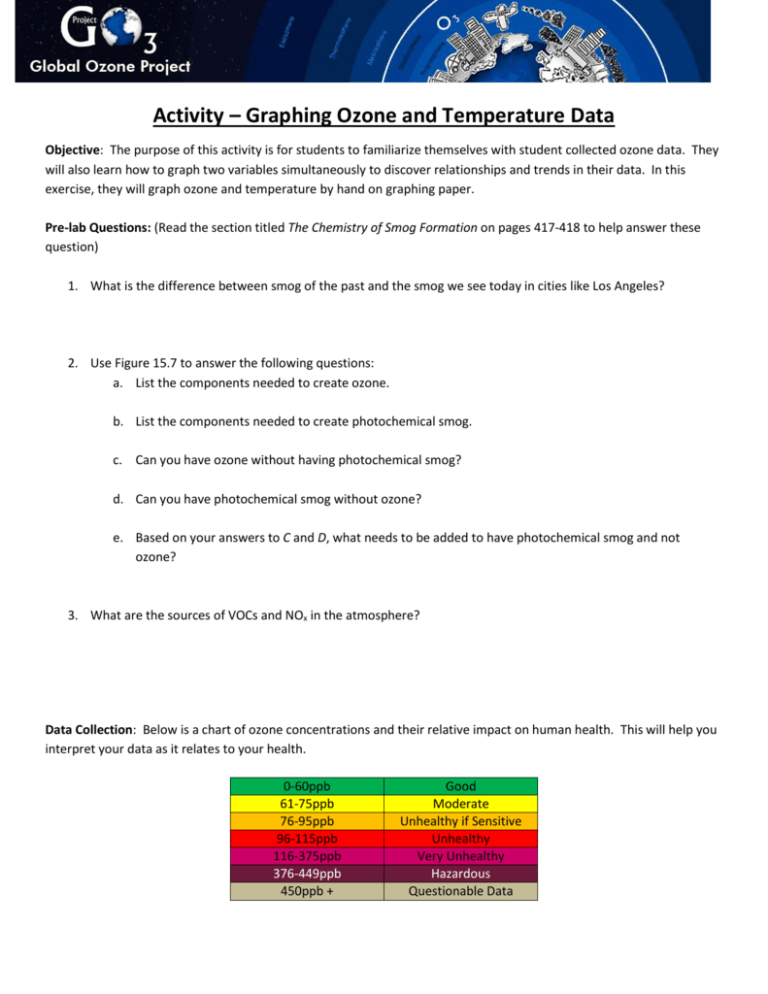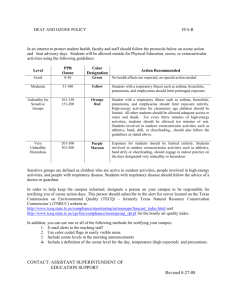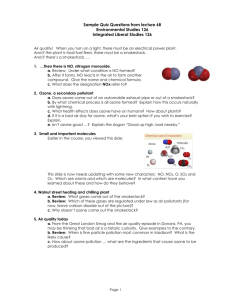Activity – Graphing Ozone and Temperature Data
advertisement

Activity – Graphing Ozone and Temperature Data Objective: The purpose of this activity is for students to familiarize themselves with student collected ozone data. They will also learn how to graph two variables simultaneously to discover relationships and trends in their data. In this exercise, they will graph ozone and temperature by hand on graphing paper. Pre-lab Questions: (Read the section titled The Chemistry of Smog Formation on pages 417-418 to help answer these question) 1. What is the difference between smog of the past and the smog we see today in cities like Los Angeles? 2. Use Figure 15.7 to answer the following questions: a. List the components needed to create ozone. b. List the components needed to create photochemical smog. c. Can you have ozone without having photochemical smog? d. Can you have photochemical smog without ozone? e. Based on your answers to C and D, what needs to be added to have photochemical smog and not ozone? 3. What are the sources of VOCs and NOx in the atmosphere? Data Collection: Below is a chart of ozone concentrations and their relative impact on human health. This will help you interpret your data as it relates to your health. 0-60ppb 61-75ppb 76-95ppb 96-115ppb 116-375ppb 376-449ppb 450ppb + Good Moderate Unhealthy if Sensitive Unhealthy Very Unhealthy Hazardous Questionable Data Graph your Data: Using the data in the data table below, graph both temperature and ozone on a line graph on your graphing paper, with time and date on the x-axis and ozone and temperature on the y-axis. Graph the Date and Time on the x-axis vs. the ozone and temperature on the y-axis. Include a title, labels, and legend. Identifying Points on Your Graphs: Locate and mark the regions on your graphs where you see the peak (maximum) values of ozone. Record the time of day, the ozone concentration and the temperature associated with each peak. You could have only two peaks, or you could see more. Record information for up to four peaks. Peaks Date Time Ozone (ppb) Temperature (F°) 1 2 3 4 Also locate and mark the regions on your graph where you see the minimum values of ozone. Note the time of day, the amount of ozone and the temperature associated with up to four minimums. Minimums Date Time Ozone (ppb) Temperature (F°) 1 2 3 4 Concluding Questions: After you have created your graphs and identified important points on your graphs, answer the following questions. Use the back if you need to. 1. What is the maximum ozone concentration you saw during this time period (don’t forget units)? 2. Using the scale for ozone concentrations and human health above, what range is your peak concentration in, for example Good, Unhealthy, etc.? 3. Explain why we typically see peak ozone formation in the late afternoon. 4. Explain why ozone decreases to nearly zero at night, but photochemical smog could persist into the night. 5. What is the difference between a cause and effect relationship between variables, as opposed to a correlational relationship? Identify the type of relationship between temperature and ozone concentration and justify your choice.







